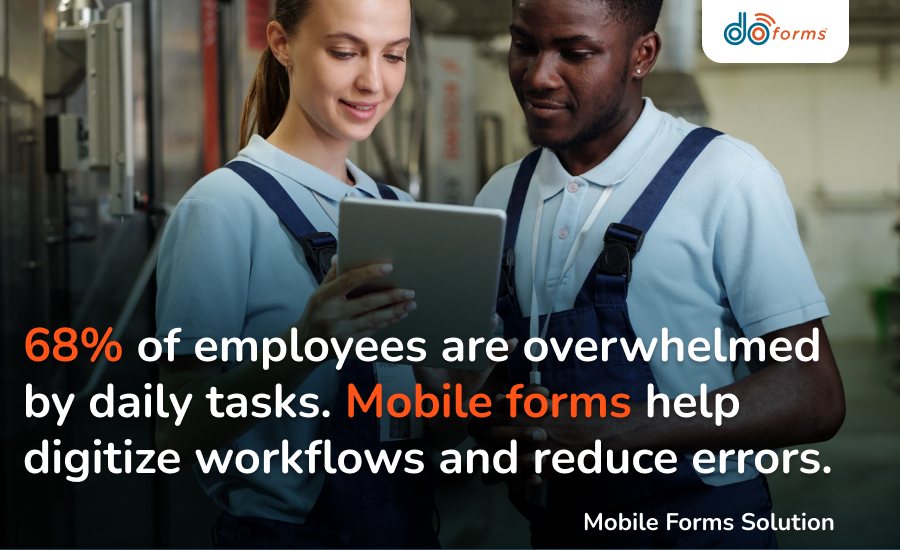
In 2021, corporate networks worldwide experienced a 50% increase in cyber attacks, compared to 2020. Considering this stagging statistic, it’s no stretch to say that if you’re not actively protecting your sensitive data, it’s at risk.
One such way to protect your network is by implementing a mobile device management (MDM) policy.
If you’re not sure where to start, you’ve come to the right place.
We’ll cover everything you need to know about an MDM policy, including how to create one and how to simplify the process by ditching the paperwork and going digital with our mobile form solutions.
Table of Contents
Need to create an MDM policy?
Try doForms for free!
What Is A Mobile Device Management (MDM) Policy?
A mobile device management (MDM) policy is a set of guidelines that dictate how your employees should use and protect mobile devices in order to keep your company’s data safe.
This policy applies to all of your employees, including part-time, full-time and contractual workers and covers devices such as smartphones and laptops.
A mobile device management policy can be created using a Word document, where each guideline is manually typed, edited and saved, then the form is printed and distributed.
At doForms, we offer a simplified process that allows you to ditch the outdated paperwork approach, which can be costly, wasteful and time-consuming. Creating an MDM policy digitally instead allows you to store the form in the cloud, and edit, save and send whenever needed.
4 Types Of MDM Policies
There are four main types of mobile device management policies. The type that’s right for your business depends on several factors, including whether the devices are private or company-issued, and the level of protection you need for your data.
1. Bring Your Own Device (BYOD)
A BYOD policy allows your employees to use their own mobile devices to perform both personal and work-related tasks. This is considered the bare minimum approach to an MDM policy, as it can carry significant cybersecurity risks.
With this policy in place, corporate control does not go beyond work-related tasks and applications, in addition to connectivity.
2. Corporate-Owned, Personally Enabled (COPE)
A COPE policy allows you to manage mobile devices that you purchase for your employees.
While your employees can also use these devices for personal use, they are required to adhere to the guidelines outlined in the policy. These guidelines typically include limits to the applications and software that is permitted to be installed.
3. Choose Your Own Device (CYOD)
A CYOD policy allows your employees to choose a mobile device from your list of approved devices.
Approved devices might include a smart phone or laptop, or an Android or Apple operating system, depending on your company’s needs.
In this policy, you can choose to purchase devices for your employees or you can allow them to use their own device.
4. Corporate-Owned, Business Only (COBO)
A COBO policy is the most restrictive mobile device management policy. In this model, you provide the device for your employee and they are only permitted to install apps that are work-related and approved.

You can choose from different types of MDM policies to find the one that works best for your business
Why Create An MDM Policy? The Top Workplace Cyber Threats
From phishing attacks to ransomware, an MDM policy can help secure your company’s sensitive data and protect your network from being hacked by cyber criminals. The top cyber threats your business is likely facing today include:
1. Phishing Attacks
Phishing messages are often sent with a malicious link that can lead to sharing sensitive information such as log-in credentials.
This occurs when a threat actor sends messages to your employee while pretending to be a trusted person — say, your HR manager.
Phishing is likely more common than you think. In fact, a recent industry report found that 86% of companies worldwide had at least one employee unknowingly try to connect to a phishing site in 2020.
2. Malware Attacks
A malware attack is a common cyber threat where malware or malicious software performs unwanted actions on your employee’s system.
Malicious software can spread a virus, slow down a computer and display unwanted ads on the screen while online.
3. Ransomware
Ransomware attacks often occur when your employee unknowingly visits a malicious website where malware is automatically downloaded.
This allows a cyber criminal to hack your employee’s system and hold your data hostage for ransom money.
Like phishing attacks, ransomware is also a common threat in the workplace. According to a recent industry report, 61% of businesses in 2020 experienced a ransomware attack that caused a system downtime of an average of three days.
4. Man-in-the-middle Attack
A man in the middle (MITM) attack occurs when a cyber criminal positions himself in a conversation between your employee and an application.
The cyber criminal’s goal in this type of attack is to impersonate your employee or the application, or to eavesdrop so he can access your employee’s browser to gather sensitive data.
How To Create An MDM Policy Step-By-Step
A mobile device management policy allows you to communicate clear employee expectations and establish guidelines to follow during employment with your company.
Here are five steps to take to create your MDM policy:
1. Establish Which Devices Are Appropriate
First, establish which devices your employees are allowed to use to access company data, whether this includes personal or company-issued smart phones, laptops or tablets.
Whichever devices you choose to allow, ensure they undergo regular security updates to help prevent cyber attacks.
2. Define Your Device Approval Process
After establishing which devices are appropriate, your IT team should document the device approval process.
Consider three key factors in the process: Whether the device is the latest model, whether it has the latest security patches or updates and whether it is running on your company’s required operating system.
3. Manage And Restrict Apps
With a mobile device management policy, your IT team can integrate mobile device management software into your employee’s mobile devices to remotely manage, install and blocklist unnecessary apps and websites.
Managing and restricting apps can prevent:
- Non-related work apps (such as games and video streaming apps) from interfering with employee productivity
- Malicious apps from compromising your company’s data
4. Outline Employee Responsibilities
Outline a standard set of mobile device security guidelines for your employees to follow, such as mandatory attendance of a cybersecurity training session.
Defining employee responsibilities helps your employees understand how they can strengthen your cybersecurity and what they can and can’t do with their mobile devices.
5. Enforce Your MDM Policy
Enforce your mobile device management policy to ensure employees comply with safety protocols.
To enforce your policy:
- Set clear employee expectations of what should and shouldn’t be done with mobile devices
- Coordinate with your HR department to impose consequences if your employee doesn’t follow your policy, to prevent compromising company data
Ready to create an MDM policy?
Try doForms for free!
Top Mobile Device Management Best Practices
Creating a mobile device management policy is only one of the many solutions you can use to ensure your company is secure from potential cyber attacks.
To further improve your cybersecurity measures, ensure that your employees follow these top mobile device management best practices.
1. Conduct Employee Cybersecurity Training
If your employees don’t know how to prevent cyber threats from occurring — for example, how to recognize suspicious phishing mails — your company’s security is at risk.
Hire a cybersecurity consulting firm to provide your employees with cybersecurity awareness and training so they can recognize threats and prevent them from escalating.
2. Require Multi-Factor Authentication
Prepare for unforeseen circumstances, such as a stolen or lost device that ends up in the hands of a stranger. To prevent the possibility of data theft, require a PIN or a multi-factor authentication on every device.
3. Back Up Your Data With Cloud Security
Cloud security allows you to access your data, even if your device is stolen, lost or broken. Store data on the cloud with a provider like Dropbox, iCloud or Google Cloud.
4. Keep Your Software Updated
Outdated software is vulnerable to hackers because it lacks the latest security updates that prevent new pieces of malware. Install the latest software patches and updates so your employee’s mobile devices have the latest security fixes and features to secure your system.
5. Avoid Public WiFi
If your employees work remotely, they may be connecting to public networks that aren’t secure.
Connecting to a public WiFi increases the opportunities for hackers to intercept your data through Domain Name System (DNS) hijacking.
If possible, considering adding a public WiFi limitation to your MDM poicy to help increase data security.

doForms allows you to ditch the time-consuming paperwork when creating your MDM policy
Create A Digital MDM Policy Using doForms
Manually creating, editing, printing and distributing your mobile device management policy can be time-consuming and costly. In fact, a recent report found that an average business spends as much as $8,000 per year on paper alone!
doForms is a mobile forms software solution for data collection, workflow management and business forms.
Our mobile forms solutions store your mobile device management policy in a secure location where your team can view existing policies from any device, at any time, while saving you from the hassle of dealing with paperwork.
From an MDM policy to employee time sheets, reports, checklists and more, doForms offers a comprehensive library of mobile forms, as well as a custom option where you can start from scratch and create your own!
With doForms, you can:
- Save money by going paperless
- Create and customize your MDM policy
- Easily edit, send and save your mobile forms
- Store your forms in one secure location where only authorized employees can access it
- Access your data through our convenient app, whether at home, in the office or on the go
Going digital has never been more secure, more convenient and cost-efficient.
Say goodbye to outdated paper forms.
Try doForms for free!
MDM Policy Key Takeaways
An MDM policy helps ensure that your employees protect your company from data theft by defining guidelines of what they should and shouldn’t do when using their mobile devices to access company information.
While paperwork policies can be tedious, disorganized, difficult to edit and costly, doForms mobile forms solutions allow you to streamline the process of creating, editing, sending and saving your mobile device management policy.
Leave the paperwork behind with doForms — go digital, reduce costs and improve your processes with a few taps right from your fingertips.




